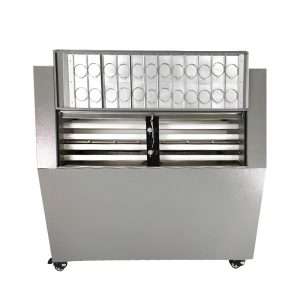UVエージングボックスの自動車内装への応用
The purpose of UV aging tests is to evaluate the weather resistance of automotive interior materials and determine their service life and performance under long-term UV irradiation and climatic conditions. Uv irradiation has the following effects on automotive interior materials:
色褪せ: UV irradiation can cause the color of automotive interior material surfaces to fade or fade.
Decreased durability: UV irradiation can reduce the durability of automotive interior materials, making them brittle, ひび割れ, or losing elasticity.
変形: Long-term UV irradiation can cause deformation of automotive interior materials, 変形などの, プラスチック材料の反りや歪み.
UVエージングボックスの自動車内装への応用
Reduced wear resistance: UV irradiation can lead to a reduction in the surface hardness of automotive interior materials, thus affecting their wear resistance.

参照基準
The industry standards for UV aging test of automotive interior materials mainly include the following:
ISO 4892-2: This standard specifies methods and procedures for UV radiation aging tests of plastic materials under laboratory conditions and is suitable for evaluating the weather resistance of automotive interior materials.
SAE J2412: This is a standard developed by the Society of Automotive Engineers that specifies the methods and requirements for UV irradiation aging testing of automotive interior materials.
UVエージングボックスの自動車内装への応用
具体的な応用例
The specific application of UV aging test box in automotive interior is as follows:
Seat materials: For materials such as fabric, leather and faux leather of car seats, UV aging tests can evaluate their color stability and durability.
Instrument panels: Automotive instrument panels are often exposed to sunlight, and UV aging tests can evaluate their resistance to fading, crack and deformation.
Interior panels: For plastic interior panels and trim pieces, UV aging tests can evaluate their color stability, 耐久性, and surface quality changes.
The application of UV aging box in automotive interior is illustrated in Figure 2
UVエージングボックスの自動車内装への応用
試験方法
Using UV aging test chamber to test the aging resistance of automotive interior materials, 一般に、次の手順に従って実行できます。:
Prepare samples: according to the characteristics and dimensions of actual automotive interior materials, 要件を満たすサンプルを準備する.
試験条件の設定: according to the test requirements or applicable standards, set the UV radiation intensity, 温度, humidity and other test conditions.
サンプルの配置: Place the sample of automotive interior materials on the sample table in the UV aging test chamber to ensure that the sample is exposed to the light source of UV radiation.
UVエージングボックスの自動車内装への応用
Run test: Allow the sample to be continuously exposed to UV radiation and other test conditions for a certain period of time according to the set test conditions.
Observation and evaluation: Regularly observe and evaluate the changes of samples, 色の変化も含めて, surface conditions, 物理的特性の変化, 等, and record and record relevant data.
Analysis of results: The aging resistance and expected life of automotive interior materials were evaluated based on the sample changes and performance losses observed during the test.
* Test procedures and parameter Settings should be adjusted and confirmed according to test standards, characteristics of automotive interior materials and actual needs. テストの精度と信頼性を確保するために、UV 老化テストを実行する前に、該当する規格と関連する機器の説明書を参照することをお勧めします。.
